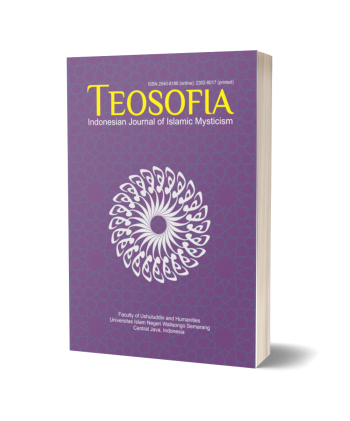SULUK LITERATURE AS A POLITICAL STRATEGY OF JAVANESE KINGDOM
DOI:
https://doi.org/10.21580/tos.v1i1.620Keywords:
suluk, literature, mysticism, moral, politics, palace, loyalty, kingAbstract
The growth of Javanese literature cannot be separated from the role of the king and the royal poet. Efforts to develop the field of literature through copying and writing of the manuscript by the court have some political motivation associated with the status quo of the kingdom. One of literary mysticism or Sufism was moral education. During the reign of the king of Surakarta and Yogyakarta, 18th to 19th century, appeared the writing of literary works within the kingdom in the form of poetry or prose, describing the idea to preserve the king's majesty. Manunggaling kawula gusti political kingdom adopted a concept of mysticism about the peak of human closeness to God. The doctrine was developed to get the support of the people to the king through absolute obedience to the king's adherence to human for God. King controlled the people and the earth. King was called as God's representative on earth (khalīfatullāh). It was revealed in the title used by the king of Mataram like Sultan Agung Anyakrakusumo Sayidin Panatagama Khalifatullah. Literary works of Kraton Surakarta and Yogyakarta until the 19th century marked by political objectives, namely to strengthen the weakening of royal power. In addition, literature was an effective tool of political communication between the king and their people, regarded as heirlooms that contain magic. Then people will be respectful and careful in dealing with the sacred text. Through writing, ruler of the kingdom sent the messages and teachings that need to be understood and adhered to by the people.
Downloads
References
Azra, Azyumardi, Jaringan Ulama: Timur Tengah dan Kepulauan Nusantara Abad XII dan XVIII Bandung; Mizan,1995.
Geertz, Clifford, Abangan, Santri dan Priyayi dalam Masyarakat Jawa, translated by Aswab Mahasin, Jakarta; Pustaka Jaya, 1989.
Geldern, R. Heine, “Conception of State and Kingship in South East Asia” in The Far Eastern Quaterly, II, Nopember 1942.
Graff, H.J. de, Kerajaan-Kerajaan Islam Pertama di Jawa , Jakarta: Grafitti Pers, 1980.
Kamajaya, Karkono Partokusumo, Kebudayaan Jawa: Perpaduan dengan Islam, Yogyakarta: IKAPI,1995.
Kartodirdjo, Sartono,A Sudewa, Suhardjo Hatmosuprobo, Perkembangan Peradaban Priyayi, Yogyakarta: Gajah Mada University Press,1993.
_________, Beberapa Segi Etika dan Etiket Jawa, Jakarta: Departemen Pendidikan dan Kebudayaan,1987.
Koentjaraningrat, Kebudayaan Jawa,. Jakarta: Balai Pustaka, 1984
Koentowijoyo, Paradigma Islam: Interpretasi untuk Aksi, Bandung: Mizan, 1999
Moedjanto, G., Konsep Kekuasaan Jawa, Yogyakarta: Kanisius, 1987.
Moertono, Soemarsaid, Negara dan Usaha Bina Negara di Jawa Masa Lampau, Jakarta: Yayasan 0bor Indonesia, 1985.
Muchtarom, Zaini, Santri dan Abangan di Jawa, Jakarta: INIS, 1988. Nasution, Harun, et.al., Ensiklopedi Islam, Jakarta; Djambatan, 1992.
Nicholson, Reynold A, The Mystics of Islam, London & Boston: Routledge And Kegan Paul,1974. Poerbatjaraka, Tardjan Hadidjaja, Kepustakaan Jawa, Jakarta: Djambatan, 1952.
Poesponegoro, Marwati Djoened, dan Nugroho Notosusanto, Sejarah Nasional Indonesia, Jakarta: Balai Pustaka, 1984.
Poerwokoesoemo, Soedarisman, Kadipaten Pakualaman, Yogyakarta: Gadjah Mada University Press, 1985.
Pigeaud ,Theodore G TH, Literature of Java,Volume III,The Hague, Martinus Nyhoff,1967.
Remmelink, Willem, The Chinese War and the Collapse of the Javanese State 1725-1743, Leiden: KITLV, 1994.
Ricklefs, Merle C., “Islamising Java: The Long Shadow of Sultan Agung”, in Archipel, 56, 1998.
_________, The Seen and Unseen Worlds in Java 1726-1749, Honolulu: University of Hawai Press,
_________, A History of Modern Indonesia, Bloomington: Indiana University Press, 1981
_________, War, Culture and Economy in Java 1677-1726: Asian and Euiropean imperialism in the early Kartasura Period, Sydney: Asian Studies Association of Australia, 1993
_________, Jogjakarta under Sultan Mangkubumi 1749-1792: A History of the Division of Java, London: Oxford Universitu Press, 1974.
Simuh, Sufisme Jawa: Transformasi Tasawuf Islam ke Mistik Jawa, Yogyakarta: Yayasan Bentang Budaya,1996.
_________, Mistik Islam Kejawen: Raden Ngabehi Ranggawarsita, Jakarta: UI Press,1988. Suhartono, Apanage dan Bekel: Perubahan Sosial di Pedesaan Surakarta, Yogyakarta: Tiara Wacana, 1991.
Suseno, Franz Magnis, Etika Jawa, Jakarta: Gramedia Pustaka Utama, 1993
Sutherland, Heater, “Priyayi in Java”, Indonesia , 1984.
Downloads
How to Cite
Issue
Section
License
Copyright
The copyright of the received article shall be assigned to the journal as the publisher of the journal. The intended copyright includes the right to publish the article in various forms (including reprints). The journal maintains the publishing rights to the published articles. Therefore, the author must submit a statement of the Copyright Transfer Agreement.*)
Licensing

This work is licensed under a Creative Commons Attribution-ShareAlike 4.0 International License.
In line with the license, authors are allowed to share and adapt the material. In addition, the material must be given appropriate credit, provided with a link to the license, and indicated if changes were made. If authors remix, transform or build upon the material, authors must distribute their contributions under the same license as the original.
_______
*) Authors whose articles are accepted for publication will receive confirmation via email and send a Copyright Transfer Agreement.











